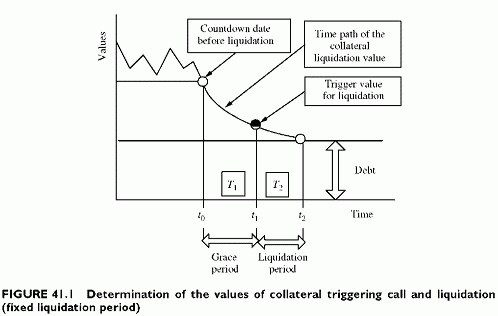RECOVERY AND EXPECTED LOSS
Category: Risk Management in Banking
In addition to being a major ingredient of loss under default, the recovery rate serves to calculate expected loss, which characterizes the risk of facilities. The expected loss is as the product of a default probability DP and expected recovery rate 1 — Lgd .For instance, a 3% default probability combined with an expected recovery rate of 70% results in an expected loss of 30% x 3% = 0.09%. This percentage corresponds to the default probability of a rating close to investment grade, whereas the default probability alone would correspond to a speculative grade in the rating scales. Default probabilities better characterize issuers risk. Expected loss better characterizes facility or issue risk. Both inputs, default probability and recovery rate or loss under default, provide an easy link towards ratings, by mapping expected loss percentages to ratings. The mapping is identical to the mapping between ratings and default probabilities of unsecured loans. When there is no recovery, the expected loss becomes 100% x DP, or the default probability, which characterizes the issuer.
COLLATERALIZED SECURITIES RISK MODELLING
In collateral agreements, the borrower is committed to post at any time a quantity of securities such that the debt remains below a certain agreed percentage, lower than 100%, of the value of pledged assets or, equivalently, such that the posted collateral remains above 100% of the loan. What follows applies to margin borrowing, lending and borrowing of securities (repos).
If the collateral amount is set only once, at origination of the debt, there is a significant chance that the collateral value will fall below the outstanding debt when time passes. In such cases, the safety cushion, defined as the excess collateral (collateral value posted minus debt), should be high enough (200% of the debt, for example) to absorb most long-term fluctuations of the market. To avoid such high over-collateralization, contractual rules impose frequent adjustments of the collateral value, by pledging more, or less, securities. If 100% represents the reference debt amount, the posted collateral has to be above 100%. The excess amount of collateral above debt depends on worst-case calculations of the deviation of its value between consecutive revaluations. For instance, if the debt is 1 million EUR and the collateral is 120%, its value is 1 200000 EUR. If the collateral value falls below 1 200 000 EUR, the lender should post additional securities or repay a fraction of the debt. It is necessary to consider various parameters to decide what is the adequate level of over-collateralization:
• The notification period, necessary to notify the lender of a collateral deficiency. We consider here that it is zero for simplicity. The notification date is t0.
• The period T allowed as a grace period for the borrower to respond to a call (a small number of days, such as 2). At the end of period T1, liquidation of securities begins if the borrower does not respond. This date is t1 = t0 + T1.
• The length of time required to liquidate the collateral, constrained by the market liquidity and the volume of securities. For instance, we might consider selling no more than 20% of the daily trading volume to avoid large price declines, and a liquidation period T2 of 3 days. At date t2 = t0 + T + T2, the liquidation is complete.
• The market volatilities and the sensitivity of the pool of securities pledged against the debt.
The total amount of time T that elapses before selling the collateral sums up the grace period T1 and the liquidation period T2: T = T1 + T2.
The collateral value is volatile. Its overall sensitivity to the underlying market parameters as a percentage is s. The daily volatility of the market parameter is crm. The daily volatility of the collateral value, for a given time period in days, is s x T. If the collateral value follows a simple normal distribution, the loss percentile at the 1% confidence level is 2.33 x s x om\fT. The downward deviation of the collateral value at this confidence level is 2.33 x s x om\fT. From this value, we find the required level of collateral and the trigger threshold for calling additional collateral. The collateral value should be [(2.33 x s x am\/T) + 1] x debt. If T = 5 days, and the daily volatility is 1.58% (or 25% x V250, with a yearly volatility of 25%), the 5-day volatility is 7.91% and the value triggering a call for more collateral is 107.91%. In the above example, the collateral is 120%. The call for additional collateral occurs at 107.91%, to have less than a 1% chance of loss if the borrower fails to adjust the collateral.
This is a simple calculation. Notification occurs at date t0, liquidation begins at date t1 and lasts for a period equal to T2 — T1. During this liquidation period, the securities price keeps falling, but remains above the debt value. At the end of the liquidation period, the average sale price moves somewhere within the price at date T1 and the price at T = T1 + T2. Hence, the proceeds from liquidation are above the debt value, so that the above rule is conservative (Figure 41.1).

